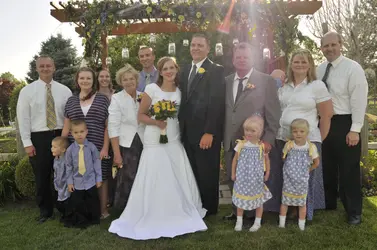Yes, the better way is called using a lens hood. And/or not shooting almost directly into the sun, which appears to be only a few degrees above the top of your frame. They would have been much happier with a group shot that has a boring sky behind it (if you pivoted the whole shot 180 degrees around, or 90 degrees, or anywhere else) than they will be with a group shot with a cute trellis and giant spikes of magenta everywhere.
I don't know what else to tell you. This photo is pretty much completely trashed by that flare, and there is about 0% chance of it being saved.
1) Always use a lens hood outdoors on every lens unless you WANT flares
2) Don't shoot anywhere near the sun being close to the frame unless you again want flares or otherwise really know what you're doing and it is very intentional.
3) Check your images as you're taking them, at least ones like this that require a lot of effort to get everybody set up. Checking quick candids and rapid fires will slow you down too much potentially, but for these, you want to make sure you got it before people disperse. Checking for obvious flares, obvious missed focus, and the histogram.
4) Considering that you have a Nikon D300S, and you shot this at exactly 18mm, and max aperture is 3.6, I'm guessing you were using an 18-200 kit lens at its widest setting. Kit lenses aren't known for fantastic performance at their extremes, and wide angles aren't known for fantastic flare prevention in general. This is a recipe for bad flares in general waiting to happen right in the lens settings themselves. You may want to upgrade your wide angle options if this is a sort of shot you want to do, in addition to the things above. Also kit lenses often don't come with hoods. See #1.
5) It's been over a month since you did the shoot. Clients might be happier with faster turnaround than that, plus now doesn't seem like the best time to be beginning to tackle an issue like this one in particular.
To be quite honest, I suggest you hold back on the wedding photography for the moment. The shot itself isn't the end of the world, and we all make mistakes sometimes. If that were all there was to it, I would try not to assume. But the fact that you are seriously asking if this can be saved in photoshop is pretty clear evidence that you almost certainly do not have the experience levels to be a smooth and efficient wedding photographer. And the 10x slow zoom lens choice and lighting in that photo do not do much in the way of altering that impression.
This particular niche is not kind on people who do not have a ton of portraiture experience yet. Gaining more experience with studio shots (for in depth lighting experience) and also one on one or small group on location things (engagement photos, for example) before trying weddings again may be a good idea. Much lower pressure, and if you get a whole batch of photos with flares, for example, you could just refund your client without losing TOO much face, rather than irreversibly missing a photo opportunity in a once in a lifetime event, which is probably much worse for your reputation and word of mouth.
 I need this photo edited is there a better way to take away the purple lens flare other than the clone tool or healing brush tool? I'm not sure what to do at this point because I don't want to spend hours on this. I need this done now to get back to the customer? Any help would be appreciated! thank you!
I need this photo edited is there a better way to take away the purple lens flare other than the clone tool or healing brush tool? I'm not sure what to do at this point because I don't want to spend hours on this. I need this done now to get back to the customer? Any help would be appreciated! thank you!




![[No title]](/data/xfmg/thumbnail/31/31086-ae0d6678ca78859132ce5375d5300961.jpg?1734159204)








